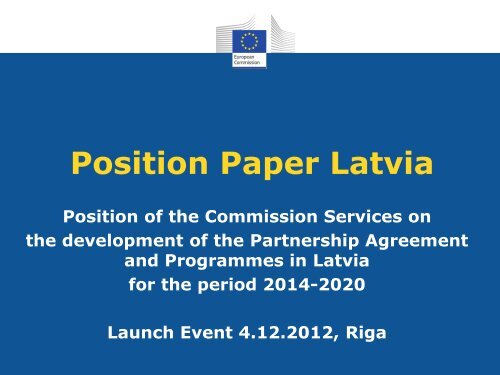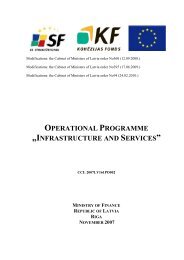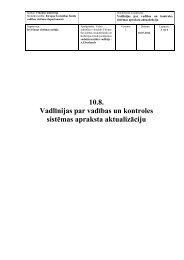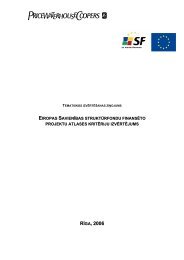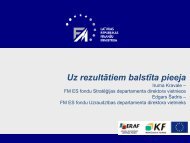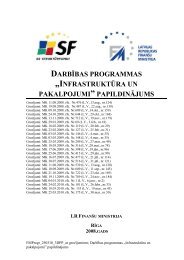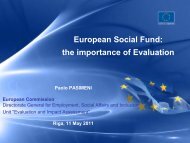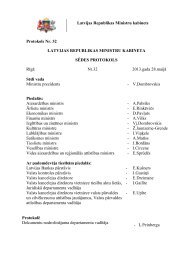Position Paper Latvia - ES fondi
Position Paper Latvia - ES fondi
Position Paper Latvia - ES fondi
Create successful ePaper yourself
Turn your PDF publications into a flip-book with our unique Google optimized e-Paper software.
<strong>Position</strong> <strong>Paper</strong> <strong>Latvia</strong><br />
<strong>Position</strong> of the Commission Services on<br />
the development of the Partnership Agreement<br />
and Programmes in <strong>Latvia</strong><br />
for the period 2014-2020<br />
Launch Event 4.12.2012, Riga
Background<br />
• Pro-active approach: early stage information on<br />
Commission's services position on priorities 2014-20 to<br />
Member States<br />
• Framework for dialogue between Commission services<br />
and Member States<br />
• Closer alignment with EU2020 strategy and Country<br />
Specific Recommendations (National Reform<br />
Programme)<br />
2
Legislative process outline<br />
• Commission proposals October 2011 (amended in<br />
September 2012)<br />
• Negotiations in Council and European parliament<br />
(ordinary legislative procedure)<br />
• Partial general agreement (General Affairs Council<br />
(16.10))<br />
• European Council in November (MFF)<br />
• European Parliament REGI committee adopted in July<br />
amendments to Regulation<br />
• Trilogues: July, September and October<br />
3
EU level<br />
THE COMMON STRATEGIC FRAMEWORK<br />
ERDF, <strong>ES</strong>F, CF, EAFRD, EMFF<br />
National<br />
•<br />
level<br />
THE PARTNERSHIP AGREEMENT<br />
ERDF, <strong>ES</strong>F, CF, EAFRD, EMFF<br />
National or<br />
regional level<br />
Operational<br />
Programmes for ERDF<br />
Operational<br />
Programmes for <strong>ES</strong>F<br />
Operational<br />
Programmes for CF<br />
Rural development<br />
programmes<br />
(EAFRD)<br />
Operational<br />
Programmes for<br />
(EMFF)<br />
Multifund Operational<br />
Programmes for ERDF,<br />
<strong>ES</strong>F, CF<br />
4
Common Strategic Framework<br />
Reinforced:<br />
• Strategic, integrated, coordinated and coherent<br />
approach<br />
• Thematic concentration<br />
• Prioritisation for visible results<br />
• Results orientation<br />
• Co-operation<br />
• Simplification<br />
5
Economic situation in <strong>Latvia</strong><br />
• Rapid recovery - economy expanded by 5.5% in<br />
2011<br />
• GDP per capita 58 % of the EU-27 average in<br />
2011<br />
• High economic disparities among <strong>Latvia</strong>n regions<br />
• Employment rate 67.2% in 2011<br />
• Long-term unemployment 8.4% of active<br />
population in 2011. Youth unemployment 31% in<br />
2011<br />
• 40% of the population at risk of poverty and<br />
social exclusion 6
Main challenges<br />
Low competitiveness and poor research and<br />
innovation performance<br />
Underdeveloped and territorially unbalanced<br />
infrastructure<br />
High unemployment, including of youth, skills<br />
mismatch and social exclusion<br />
High energy intensity and inefficient use of natural<br />
resources<br />
7
Low competitiveness and poor research<br />
and innovation performance<br />
CHALLENG<strong>ES</strong><br />
• Low productivity level of enterprises and low share of<br />
innovative companies<br />
• Lack of market-driven access to capital, difficulties to attract<br />
foreign direct investments<br />
• Underdeveloped advanced business services and slow take-up<br />
e-commerce<br />
• Fragmented RTD&I system<br />
• Shortage of skilled labour<br />
• Corruption<br />
• Failings of the <strong>Latvia</strong>n judicial system hindering business and<br />
economic activity<br />
8
Underdeveloped and territorially<br />
unbalanced infrastructure<br />
CHALLENG<strong>ES</strong><br />
• No direct railway connection with Central Europe, low<br />
electrification level of railway network<br />
• Poorly maintained and fragmented public transport<br />
• Augmenting transport GHG emissions due to the high usage of<br />
personal cars, rather than public transport<br />
• Poor quality of roads leading to high accident rate<br />
• Energy network needs improvement<br />
• Penetration rate of fixed and mobile broadband is below the<br />
EU average<br />
9
High unemployment, including of youth,<br />
skills mismatch and social exclusion<br />
CHALLENG<strong>ES</strong><br />
• High unemployment, in particular for long-term<br />
unemployed, youth, low skilled<br />
• Quality and participation problems in education<br />
leading to skills mismatch<br />
• High number of people at risk of poverty or social<br />
exclusion, weak social protection and social work<br />
10
High energy intensity and inefficient<br />
use of natural resources<br />
CHALLENG<strong>ES</strong><br />
• Energy intensity more than double the EU-27 average<br />
• Renewable energy sources require diversification<br />
• Waste management not in line with the waste hierarchy<br />
• High percentages of waste water remain uncollected<br />
• Pollution from individual and diffuse sources creates a significant<br />
burden on surface and underground water<br />
• Deficiencies in drinking water treatment, distribution and quality<br />
monitoring systems<br />
• Loss of biodiversity and wind and water erosion of soil<br />
11
Challenges for <strong>Latvia</strong> in the agricultural<br />
and fisheries sectors<br />
• Agricultural sector and rural areas<br />
• Low added value<br />
• Connection to innovation<br />
• Depopulation<br />
• Fisheries sector and coastal areas<br />
• Decreasing fishing opportunities: expected loss of jobs and<br />
profit<br />
• Many small boats<br />
• Small aquaculture sector<br />
• Less developed coastal regions<br />
12
EU2020 targets<br />
Europe 2020 targets Current situation National 2020 target NRP<br />
3% of expenditure on research and<br />
development<br />
0.6% (2010) 1.5%<br />
20% greenhouse gas (GHG) emissions<br />
reduction compared to 1990<br />
+6% (2010 non-ETS emissions<br />
compared to 2005)<br />
Based on current policies, in 2020<br />
+18%, 2020 non-ETS projections<br />
compared to 2005<br />
+17%<br />
(national binding target for non-ETS<br />
sectors compared to 2005 )<br />
20% of gross final energy consumption<br />
from renewable energy sources (R<strong>ES</strong>)<br />
32.57% (2010) 40%<br />
20% increase in energy efficiency<br />
Gross domestic energy consumption:<br />
4.54 Mtoe in 2010<br />
Energy savings of 0.668 Mtoe, including<br />
transformation sector (compared to<br />
2008 level of 4.6 Mtoe)<br />
75% of the population aged 20-64<br />
should be employed<br />
The share of early school leavers<br />
should be under 10%<br />
At least 40% of 30-34 years old should<br />
have completed a tertiary education<br />
67.2% (2011) 73%<br />
11.8% (2011) 13.4%<br />
35.7% (2011) 34-36%<br />
Reducing the number of people at risk<br />
of poverty or exclusion by 20 million in<br />
the EU<br />
19.3% (share of persons at risk of<br />
poverty or 97 000 lifted out the risk of<br />
poverty and/or jobless households by<br />
2011)<br />
21% (share of persons at risk of poverty<br />
or by lifting 121 000 people out of the<br />
risk of poverty and/or jobless<br />
households)
Funding priorities<br />
• Need for strategic orientation and concentration,<br />
the need to avoid fragmentation of investments<br />
• CSF Funds are an important tool in reaching<br />
Europe 2020 targets<br />
• Concentration among and within the thematic<br />
objectives<br />
14
Funding priorities for <strong>Latvia</strong><br />
(There is no ranking in the presentation of the funding priorities)<br />
Innovative and competitive business and research<br />
environment<br />
Modern infrastructure for growth and jobs<br />
High employment, skilled people and inclusive<br />
society<br />
Energy efficiency and sustainable management of<br />
natural resources<br />
15
Low competitiveness<br />
and poor research and<br />
innovation performance<br />
Innovative and competitive business<br />
and research environment (I)<br />
Enhancing SMEs<br />
competitiveness<br />
and innovation<br />
• Support to SME's innovation,<br />
technology transfer<br />
• Promote access to external markets<br />
and attract FDI<br />
• Support to internationalisation of<br />
SMEs<br />
• Support for business advisory services<br />
• Developing ICT products and services
Low competitiveness<br />
and poor research and<br />
innovation performance<br />
Innovative and competitive business<br />
and research environment (II)<br />
Optimising RTD&I<br />
infrastructure and<br />
capacities and<br />
expanding<br />
international cooperation<br />
• Further rationalisation, consolidation<br />
of RTD&I structures and activities on<br />
the basis of smart specialisation<br />
strategy<br />
• Increase the participation of private<br />
sector in RTD&I<br />
• Fostering links between research and<br />
industry<br />
• Opening up the national RTD&I<br />
system for international co-operation,<br />
development of clusters and networks<br />
• Highly qualified scientists and<br />
engineers
Low competitiveness<br />
and poor research and<br />
innovation performance<br />
Innovative and competitive business<br />
and research environment<br />
Optimising RTD&I<br />
infrastructure and<br />
capacities and<br />
enhancing SMEs<br />
competitiveness<br />
and innovation in<br />
agriculture<br />
• Increase competitiveness of primary<br />
producers - enhanced cooperation<br />
between enterprises and R&I<br />
• Development of networks and<br />
cooperation (European Innovation<br />
Partnerships)<br />
• Support to modernisation<br />
• Business opportunities from resource<br />
efficiency
Low competitiveness<br />
and poor research and<br />
innovation performance<br />
Innovative and competitive business<br />
and research environment<br />
Strengthening<br />
private research<br />
and creating an<br />
innovation-friendly<br />
business<br />
environment in<br />
marine and<br />
maritime sectors<br />
• Explore the potential for growth in<br />
marine and maritime sectors in line<br />
with the Blue Growth initiative<br />
• Mature marine sectors with high<br />
potential if adapted to new<br />
challenges: coastal and cruise<br />
tourism, maritime transport.<br />
• Sectors with high innovation and<br />
growth potential: biotechnology, blue<br />
energy
Low competitiveness<br />
and poor research and<br />
innovation performance<br />
Innovative and competitive business<br />
and research environment (III)<br />
Improving quality<br />
and efficiency of<br />
judiciary<br />
• Reduce backlog and length of civil<br />
procedures<br />
• Support for development of<br />
reliable quality assurance and<br />
data collection and compilation<br />
systems for the justice systems
Innovative and competitive business<br />
and research environment (IV)<br />
Thematic objectives:<br />
• Strengthening research, technological development and<br />
innovation<br />
• Enhancing the competitiveness of small and medium-sized<br />
enterprises, the agricultural sector (for the EAFRD) and the<br />
fisheries and aquaculture sector (for the EMFF)<br />
• Enhancing access to, and use and quality of, information and<br />
communication technologies – partly<br />
• Enhancing institutional capacity and an efficient public<br />
administration<br />
• Promoting employment and supporting labour mobility – partly<br />
CSRs: 3, 6 and 7 of 2012<br />
21
Underdeveloped and<br />
territorially unbalanced<br />
infrastructure<br />
Modern infrastructure for growth and jobs (I)<br />
Addressing<br />
significant gaps in<br />
transport<br />
infrastructure with<br />
a shift to<br />
environmentally<br />
sustainable modes<br />
of transport<br />
• Investing in the TEN-T (Rail Baltica)<br />
• Environment-friendly and low-carbon<br />
transport systems and urban mobility<br />
• Connecting regions to the TEN-T<br />
infrastructure
Underdeveloped and<br />
territorially unbalanced<br />
infrastructure<br />
Modern infrastructure for growth and jobs(II)<br />
Developing energy<br />
networks<br />
• Build and upgrade low-voltage<br />
distribution networks, including smart<br />
grids and integration of distributed<br />
production in the grid<br />
• Upgrade networks to ensure uptake<br />
from renewable energy sources
Underdeveloped and<br />
territorially unbalanced<br />
infrastructure<br />
Modern infrastructure for growth and jobs (III)<br />
Increasing<br />
deployment and<br />
take-up of ICT<br />
networks<br />
• Roll-out of open, accessible, affordable and<br />
future-proof Next Generation Access<br />
Infrastructure<br />
• Improvement and expansion of the<br />
broadband infrastructure, especially in<br />
remote areas
Modern infrastructure for growth and<br />
jobs (IV)<br />
Thematic objectives:<br />
• Promoting sustainable transport and removing bottlenecks in key<br />
network infrastructure<br />
• Supporting the shift towards a low-carbon economy in all sectors -<br />
partly<br />
• Enhancing access to, and use and quality of, information and<br />
communication technologies – partly<br />
CSR: 5 of 2012<br />
25
High unemployment,<br />
including of youth, skills<br />
mismatch and social<br />
exclusion<br />
High employment, skilled people<br />
and inclusive society(I)<br />
Effective active<br />
labour market<br />
policies (ALMP)<br />
• Increase ALMP coverage and<br />
activation rate<br />
• Increase employment rate of<br />
older people<br />
• Increase share of flexible modes<br />
of work<br />
• Increase regional mobility
High unemployment,<br />
including of youth, skills<br />
mismatch and social<br />
exclusion<br />
High employment, skilled people<br />
and inclusive society(II)<br />
Youth<br />
guarantees<br />
• Support implementation of the<br />
youth guarantees within four<br />
months after leaving school
High unemployment,<br />
including of youth, skills<br />
mismatch and social<br />
exclusion<br />
High employment, skilled people<br />
and inclusive society(III)<br />
High quality labour<br />
market relevant<br />
and<br />
entrepreneurshipfocussed<br />
education I<br />
• Support implementation of<br />
strategies for fighting early<br />
school-leaving<br />
• Raise skills and competence of<br />
teachers (general education and<br />
VET). Increase use of modern<br />
teaching methods and<br />
development of creative skills<br />
• Support implementation of<br />
national career guidance system
High unemployment,<br />
including of youth, skills<br />
mismatch and social<br />
exclusion<br />
High employment, skilled people<br />
and inclusive society(IV)<br />
High quality labour<br />
market relevant<br />
and<br />
entrepreneurshipfocussed<br />
education II<br />
• Raise participation in VET<br />
• Support implementation of VET<br />
in-company apprenticeship<br />
system
High unemployment,<br />
including of youth, skills<br />
mismatch and social<br />
exclusion<br />
High employment, skilled people<br />
and inclusive society(V)<br />
High quality labour<br />
market relevant<br />
and<br />
entrepreneurshipfocussed<br />
education III<br />
• Increase share of mathematics,<br />
science and technology studies'<br />
graduates<br />
• Strengthen co-operation with<br />
employers in design and delivery<br />
of programmes and quality<br />
assurance, placements and<br />
internship, workplace learning<br />
• Support development of strategic<br />
partnerships with research sector<br />
and businesses for innovation
High unemployment,<br />
including of youth, skills<br />
mismatch and social<br />
exclusion<br />
High employment, skilled people<br />
and inclusive society(VI)<br />
High quality labour<br />
market relevant<br />
and<br />
entrepreneurshipfocussed<br />
education IV<br />
• Increase participation rate in<br />
lifelong learning<br />
• Support diversification of the<br />
training offer in relevance to<br />
labour market needs and<br />
introduction of flexible modes of<br />
delivery<br />
• Support effective implementation<br />
of the qualification framework<br />
and the system for validation of<br />
non-formal and informal learning
High unemployment,<br />
including of youth, skills<br />
mismatch and social<br />
exclusion<br />
High employment, skilled people<br />
and inclusive society(VII)<br />
High quality labour<br />
market relevant<br />
and<br />
entrepreneurshipfocussed<br />
education V<br />
• Support for investments in<br />
education and training<br />
infrastructure particularly with a<br />
view to optimisation of the<br />
education system, reducing<br />
territorial disparities, increasing<br />
the responsiveness of education<br />
and training systems to evolving<br />
patterns of skills needs and<br />
demands
High unemployment,<br />
including of youth, skills<br />
mismatch and social<br />
exclusion<br />
High employment, skilled people<br />
and inclusive society(VIII)<br />
Integration of<br />
the most<br />
disadvantaged<br />
groups in the<br />
labour market,<br />
education and<br />
society<br />
• Reduce barriers to employment<br />
• Strengthen social integration of<br />
disadvantaged groups<br />
• Improve targetting of social<br />
assistance benefits<br />
• Support development of social<br />
assistance data management and<br />
monitoring system<br />
• Improve availability, quality and<br />
effectiveness of social work<br />
• Reduce share of people in institutional<br />
care<br />
• Promote inclusive education
High unemployment,<br />
including of youth, skills<br />
mismatch and social<br />
exclusion<br />
High employment, skilled people<br />
and inclusive society (IX)<br />
Promoting<br />
employment, social<br />
inclusion and skills<br />
ir coastal and rural<br />
areas<br />
• Diversification, entrepreneurship and<br />
business creation offering new<br />
opportunities for employment in<br />
coastal and rural areas<br />
• Skills development of farmers and<br />
fishermen<br />
• Community Led Local Development
High employment, skilled people<br />
and inclusive society (X)<br />
Thematic objectives:<br />
• Investing in education, skills and lifelong learning<br />
• Promoting employment and supporting labour<br />
mobility<br />
• Promoting social inclusion and combating poverty<br />
• CSR: 3, 4 and 7 of 2012<br />
35
High energy intensity and<br />
inefficient use of natural<br />
resources<br />
Energy efficiency and sustainable<br />
management of natural resources (I)<br />
Shift to energy,<br />
resource-efficient<br />
and low-carbon<br />
economy<br />
• Energy efficiency retrofitting<br />
measures in the public buildings<br />
and housing sector<br />
• Innovative energy efficiency<br />
solutions in businesses<br />
• Promoting diversification of<br />
renewable energy sources
High energy intensity and<br />
inefficient use of natural<br />
resources<br />
Energy efficiency and sustainable<br />
management of natural resources (II)<br />
Shift to energy,<br />
resource-efficient<br />
and low-carbon<br />
economy in<br />
agriculture and<br />
forestry<br />
• Enhanced energy efficiency of agriculture<br />
sector<br />
• Promoted use of renewable energy<br />
sources in agriculture<br />
• Sustainable production of renewable<br />
energy from agricultural and forestry<br />
residues
High energy intensity and<br />
inefficient use of natural<br />
resources<br />
Energy efficiency and sustainable<br />
management of natural resources (III)<br />
Protect<br />
environment,<br />
promote climate<br />
change adaptation<br />
and risk prevention<br />
in agriculture and<br />
forestry<br />
• Targeted agri-environment-climate<br />
measures<br />
• Encourage collective approaches<br />
Enhance the resilience to the adverse<br />
impacts of climate change<br />
• Address specific risks diseases<br />
• Improve water and soil management<br />
• efficiency<br />
• quality
High energy intensity and<br />
inefficient use of natural<br />
resources<br />
Energy efficiency and sustainable<br />
management of natural resources (IV)<br />
Protecting the<br />
environment and<br />
promoting resource<br />
efficiency in<br />
fisheries and<br />
aquaculture<br />
• Increase yields from fishing through<br />
better managed fish stocks<br />
• Eliminate wasteful practice<br />
(discarding) and promote efficient<br />
catching techniques with low impact<br />
on environment<br />
• Promote better knowledge and<br />
science through enhanced data<br />
collection<br />
• Improving fisheries control
High energy intensity and<br />
inefficient use of natural<br />
resources<br />
Energy efficiency and sustainable<br />
management of natural resources (V)<br />
Addressing<br />
significant needs<br />
for investment in<br />
the waste and<br />
water sectors to<br />
meet the<br />
environmental<br />
acquis<br />
• Waste water treatment infrastructure<br />
and collection networks<br />
• Drinking water infrastructure,<br />
including reductions of leakages from<br />
networks<br />
• Waste management system in line<br />
with the waste hierarchy and<br />
development of more efficient wasteto-energy<br />
systems
Energy efficiency and sustainable<br />
management of natural resources (VII)<br />
Thematic objectives:<br />
• Protecting the environment and promoting<br />
resource efficiency<br />
• Supporting the shift towards a low-carbon<br />
economy in all sectors – partly<br />
• Promoting climate change adaptation, risk<br />
prevention and management (EAFRD)<br />
• CSR: 5 of 2012<br />
41
European Territorial Cooperation<br />
• Transnational and cross-border cooperation (for<br />
certain joint and coordinated activities and the<br />
support of the coordination process)<br />
• Mainstreaming cooperation by using its potential<br />
in all OPs (mainly coordinated, complementary<br />
and convergent activities)<br />
• EU Strategy for the Baltic Sea Region<br />
42
Territorial development<br />
• Integrated Territorial Investments (ITI)<br />
• Sustainable urban development strategies<br />
• Community Led Local Development (CLLD)<br />
43
Success factors<br />
• Strategic, integrated, coordinated and coherent approach<br />
• Targeted actions with measurable impacts<br />
• Cooperation across regions, funds & strategies<br />
• Ex-ante conditionalities:<br />
o<br />
o<br />
o<br />
o<br />
o<br />
o<br />
o<br />
National research and innovation strategy for smart specialisation<br />
Comprehensive national transport plan<br />
National strategy for poverty reduction<br />
Strategy for reinforcing administrative efficiency including public<br />
administration reform<br />
Comprehensive national broadband plan<br />
Effective implementation of EU environmental acquis in the sectors of<br />
waste management and wastewater management<br />
Strategic plan for aquaculture and improve data collection for fisheries<br />
management<br />
44
Governance of the CSF<br />
Main issues for <strong>Latvia</strong>:<br />
• Improve strategic input and efficiency of the<br />
decision-making<br />
• Simplification of the Funds' institutional set-up<br />
• Strengthening administrative capacity<br />
• Better coordination of funds and programmes,<br />
cutting administrative costs and burden for the<br />
beneficiaries, wider use of e-cohesion<br />
possibilities<br />
45
Next steps: the way forward<br />
Negotiation process for Partnership Agreement (PA)<br />
<strong>Position</strong><br />
paper sent<br />
to <strong>Latvia</strong><br />
Launch<br />
event<br />
Informal<br />
dialogue<br />
with <strong>Latvia</strong><br />
<strong>Latvia</strong> sends<br />
PA through<br />
SFC<br />
COM<br />
observations<br />
sent to<br />
<strong>Latvia</strong><br />
Timetable<br />
&<br />
List of<br />
issues to<br />
discuss<br />
CPR<br />
adopted<br />
October<br />
2012 2013<br />
December


